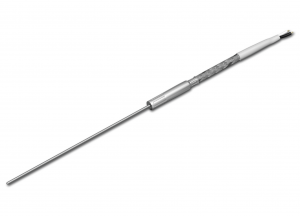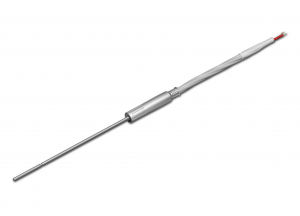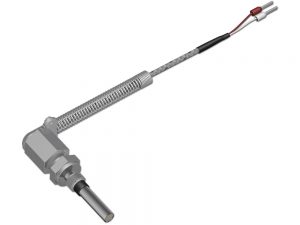
Thermocouples & sensors
As well as a large range of heating elements and temprature control units, CETAL also offers a large range of thermocouples and RTDs:
Areas of application:
- Plastics industry
- Mechanical engineering
- Steel industry
- Chemical industry
- Ceramics and glass industry
- Energy industry
- Pharmaceutical industry
- Furnace systems
- Engine test benches
- Packaging industry
- Automotive industry
A thermocouple consists of two wires made of different materials that, due to the thermoelectric effect, produce a voltage from which the temperature can be derived.
Depending on the desired application temperature, various thermocouples are available to choose from.
Type J iron/cupro-nickel acc. to DIN EN 60584 & ANSI 96.1
Type L iron/cupro-nickel acc. to DIN 43710
Type K nickel-chromium/nickel acc. to DIN EN 60584 & ANSI 96.1
Type K nickel-chromium/nickel acc. to DIN 43710
However, the following thermocouple types are also available from us on request:
- Type E, R, S, and Tacc. to DIN EN 60584 & ANSI 96.1
- Type Nacc. to DIN EN 60584
- Type Bacc. to ANSI 96.1
- Type Uacc. to DIN 43710
The measuring point can be manufactured as both grounded and ungrounded. You can select the classification tolerances according to class 1 or class 2.
Key features and advantages:
- Also suitable for use in higher temperature ranges, such as types B, R, and S, which are temperature-resistant up to 1600°C
- Short response time to temperature changes for fast reactions in the controlled system, especially with an ungrounded measuring point
- Robust against mechanical stress and less sensitive than, e.g., RTDs to shocks and vibrations
- Very widespread and well-known sensor type
- Inexpensive
RTDs are used to measure temperature in many sectors of industry. Here, an ohmic resistor is used as a temperature sensor. Its resistance value is temperature-dependent. Platinum has established itself as the chosen resistive material. The most frequently used platinum alloy is known as Pt100, which we manufacture according to DIN EN 60751.Other available sensor types are, for example:
- Pt100
- Pt500
- Pt1000
- Ni100
- Ni120
- Various NTC sensors
In order to minimize the effects of the cable resistances and their temperature-dependent variations, we manufacture sensors with connections for three- and four-cable circuits, as well as those with a two-cable connection.
You can select the classification tolerance according to class A and class B.
Key features and advantages:
- Higher measurement accuracy than thermocouples
- Optimum long-life stability
- High chemical resistance as a result of the platinum
All sensor types can in principle be supplied as a thermocouple and an RTD.
Mineral-insulated thermocouples/RTDs, also known as sheath thermocouples/RTDs, represent a special type of temperature sensors. They consist of a flexible, thin-walled, mineral-insulated cable that allows a long service life thanks to its shock-proof construction. They differ from other temperature sensors in their compact construction, fast response times to temperature changes, and flexibility, which allows their introduction into hard-to-reach measuring points.
The materials used (1.4541 and 2.4816) mean that the sleeve welds and solders well, has optimum strength properties at high temperatures, and meets the typical requirements in environments with gaseous and liquid media.
Connectors and compression fittings are available in numerous varieties.
Connection types:
- Open ends
- Connection heads
- LEMO connectors
- Compensation connectors
- Mini compensation connectors
Numerous other connection types on request.
Frequent areas of application:
- Hot-runner nozzles
- Flue-gas analysis
- Furnace construction
- Steelworks
- Laboratories
- Test facilities and test benches
Suitable for measuring temperature on injection and die-cast molds in plastic and zinc die casting. Angle sensors are beneficial wherever a straight cable outlet is not possible or not wanted, e.g. for space reasons. The connection lead’s bend-protection spring serves as mechanical protection. The sensor is fastened in place with, e.g. a compression fitting or a screw-in thread.
Insert surface sensors are used preferentially for temperature measurements in solid objects, e.g. hot-glue applicator heads or welding/sealing jaws of packing machines.
The cable’s junction with the protective tube is strain-relieved. The stainless-steel protective tube protects the measuring point from chemical influences and mechanical damage.
The sensor is fastened in place by direct insertion into the bore hole or with a flange.
Thermocouples and RTDs with a bayonet cap are used preferentially for temperature measurements in solid objects, slide bearings, and tools, e.g. for injection molding or extrusion of plastics in the plastics industry.
The probe tip’s special shape means these temperature sensors are suitable for use in plane and tapered bore holes.
The stiff compression spring made of rust- and acid-resistant stainless steel, which simultaneously acts as bend protection, ensures that the probe tip exerts consistent contact pressure in the bore hole. The installation length can be varied by twisting the bayonet cap.
The bayonet cap is available in several diameters.
Screw-in adapters are available in various designs.
Ring thermocouples were developed for temperature measurement on surfaces. They can be attached easily with a screw and are suitable for numerous areas of use, e.g. hot-runner manifolds.
For temperature measurement on pipelines and all cylindrical shapes. The sensor is welded or soldered into place. The connection lead’s bend-protection spring serves as mechanical protection.
Common names also include ‘pipe-clamp thermometer’ and ‘pipe-clamp RTD’. These are used to determine the temperature on pipelines and cylindrical bodies. They are attached using the adjustable clamping band. The connection lead’s bend-protection spring serves as mechanical protection.
For temperature measurement on tools, e.g. hot-runner manifolds.
This sensor is especially economical in terms of space and can be attached easily to the flange with a screw. The bend-protection spring on the connection lead serves as mechanical protection.
Mineral Insulated Thermocouple / Mineral Insulated RTD
General applications
- Engine compartment
- Catalytic converter
- Exhaust pipe
Mineral Insulated Screw-in Thermocouple / Mineral Insulated Screw-in RTD
General applications
- Engine compartment
- Turbocharger
- Oil pan
- Exhaust pipe
Wire Thermocouple
General applications
- Difficult accessible areas with limited space and/or if fast response times
Self-Adhesive Surface Thermocouple
General applications
- Quick, space-saving and uncomplicated temperature measurement on surfaces, e. g. on auto interior and boots
Spring Thermocouple / Friction Thermocouple
General applications
- Temperature recording on the brake disc or other rotating surfaces
Insert Thermocouple
General applications
- Temperature recording in the brake disc (For installation into the brake disc)
Terminal Strip
General applications
- Consolidates several connection leads to reduce wiring effort and save space



